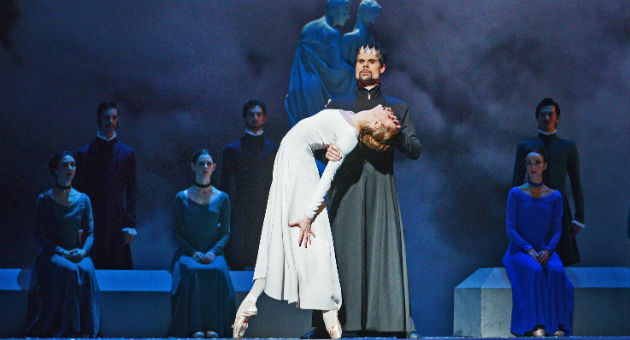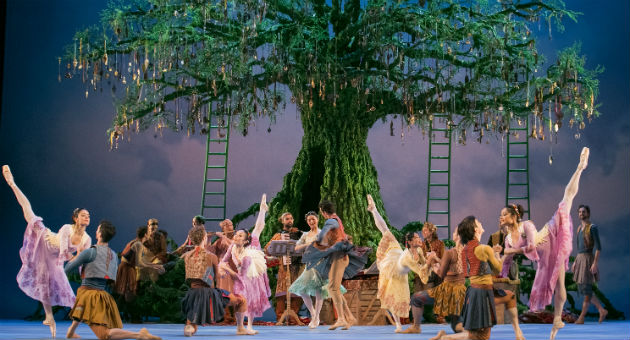The Winter’s Tale has the saddest happy ending in all of Shakespeare. Categorized as a problem play or a romance, it doesn’t end with a stage full of corpses—the King, who has lost his wife, son, daughter, and best friend entirely through his own folly gets almost everything restored to him—but the audience nonetheless leaves the theater feeling unsettled.
British choreographer Christopher Wheeldon has adapted this odd, Job-like play for the National Ballet of Canada and Royal Ballet in London, and it is now playing at the Kennedy Center (although Friday and Saturday performances have been cancelled due to the snow, and the fate of the rest of the run is uncertain).
Even streamlined for ballet, the plot is complicated. King Leontes of Bohemia loves his queen, Hermione, and his young son, Mamillius. He invites his childhood best friend, King Polixines, to come and stay with them.
Then the queen becomes pregnant with their second child. Suddenly, Leontes is convulsed by a wild jealousy. He is convinced Hermione has been unfaithful. He tries to have Polixines murdered, but Polixines escapes. He has Hermione thrown in prison. When she has her baby, Leontes orders his servant to abandon it (the servant whisks her away to safety instead, but he is eaten by a bear).
The king’s son Mamillus suddenly dies. During her trial, Hermione dies of sorrow. At this news, the spell is broken, and Leontes suddenly realizes he has been wrong about everything. The play could end here, but it doesn’t: it skips sixteen years ahead.

Leontes has spent every day repenting, largely because Hermione’s friend Paulina never lets him forget or forgive himself. Across the ocean, the baby girl, Perdita, has survived and grown up into a beautiful shepherdess. She falls in love with Polixines’s son, but they aren’t allowed to marry because she isn’t royal. The lovers run away to Bohemia, where she is recognized by Leontes. When it turns out she is a Princess, Polixines blesses the union.
Again, this could have been enough. But then there is a miracle: a statue of Hermione comes to life, sixteen years older, quietly embracing Leontes, and joyfully reuniting with her daughter. Leontes has his wife back, his friend, and his daughter. He even has a new son (in-law). Everything is almost as it was.
Despite it’s complicated plot, as a ballet, The Winter’s Tale works beautifully, perhaps because it boils down to four eminently danceable emotions: jealousy, sorrow, joy, and awe. And although it’s wordless, the production manages to bring out some interesting dimensions in the story.
In Shakespeare’s text, Leontes’s jealousy appears entirely unfounded; in the ballet, it is more ambiguous. He begins dancing alone with Hermione, their movements open, joyful, and intimate. Then, their pas de deux is joined by Polixines, who becomes intertwined with the two of them, awkwardly interrupting their duet. Hermione is literally passed back and forth between them, twirling into one and then the other. As the two kings trade off between holding her shoulders and her legs, she becomes a vessel for their growing enmity.
Hannah Fischer, as a long-necked, long-suffering Hermione, glows like an icicle lit from within. Her whole body is expressive; even the flicks of her wrists are sad. But she is strong and deliberate in her movements—fluid, but not fragile.
Leontes, played by a scowling Piotr Stanczyk, moves in the way that jealousy makes us feel: small, manic, trapped, and ugly. He folds himself in half, twisting in jerky, incomplete arcs, dragging himself backwards in repetitive circles across the stage.
In one sequence, he hides behind a statue to spy on Hermione and Polixines. They are innocently prancing and talking. Then, the lighting changes, Leontes convulses, and they are suddenly writhing, embracing. The effect is meant to show us the paranoid fantasies in Leontes’s head; but if an audience member hasn’t read the play, he might think that Leontes’s rage was justified.
The ballet also augments, perhaps for the better, the relationship between Leontes and Paulina (played by an excellent Xiao Nan Yu). In the second half of the play, Paulina is the embodiment of all of Leontes’s guilt, the hissing, relentless voice of his tortured conscience. She says terrible, true things to him constantly. In this production, she is much kinder, literally lifting him up when he collapses from grief and regret. At one point Leontes bends at the waist and rests his head in her hands as she guides him, gently but insistently, to Hermione’s tomb.

And finally, there is the miracle.
The Wheeldon ballet has pulled off the best "statue-coming-to-life" scene I’ve witnessed. In any production, the scene is always strange. It’s unclear whether the moment is a supernatural miracle or whether or not Paulina and Hermione have conspired, hiding Hermione away until she hears that Perdita has come back. The actress who plays Hermione stands perfectly still on a pedestal, usually lit to look like marble. The music swells, and she steps down, enfolding Leontes and Perdita in her arms.
But in this version, Hermione does not appear on the pedestal alone. She stands with a statue of Mamillius, who pointedly does not come back to life.
Hermione revives and embraces Perdita, and they run offstage together. Leontes stays behind. He approaches the statue of his son and touches it, hoping that it too, will spring to life. Paulina removes his hand and shakes her head. We end, remembering that, while Leontes has been very lucky, not all has been restored.
Shakespeare’s plays have been used as the basis for ballets for hundreds of years, but it still seems odd to take his works, strip them of all the poetry, and insist that they are still meaningfully "Shakespeare." After all, he stole or borrowed most of his plots, including the plot of The Winter’s Tale, which comes from a 1588 novel called Pandosto.
What seems to have been originally Shakespeare’s is the miracle. In Pandosto, the Queen dies for good and the King, repentant, kills himself. For some reason, Shakespeare decided to take a tragedy and try and put everyone back together again. This to me seems to be the lesson in this production—really, in all of Shakespeare’s problem plays, and maybe the tragedies too: do not despair. As Paulina says to Leontes as she takes him to the statue, "It is required you do awake your faith." Our happiness, or even our survival, merely depends on dumb luck and miracles, which we often don’t deserve. They are possible if we are fortunate enough to have friends who are smarter than we are, and the patience to wait.
